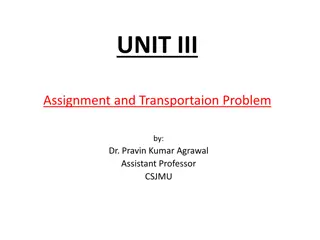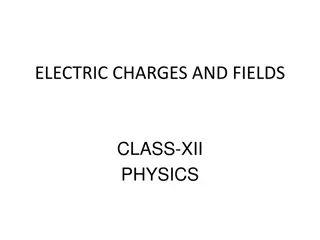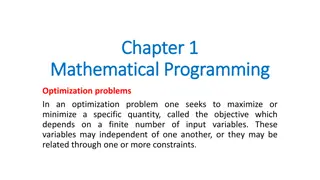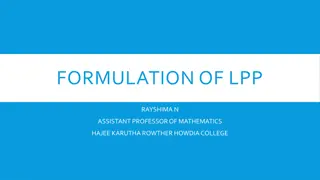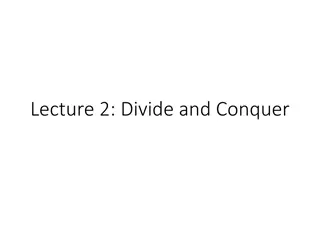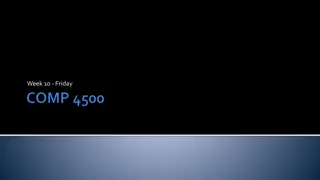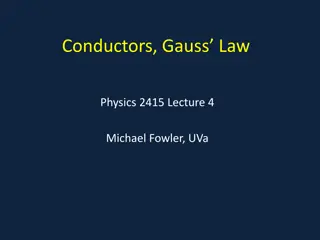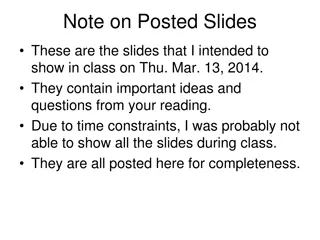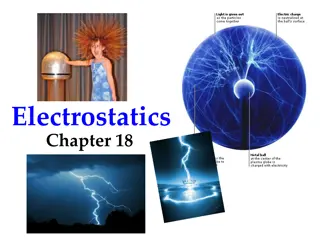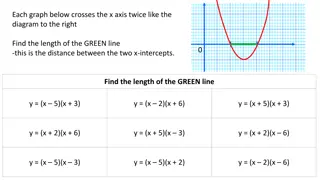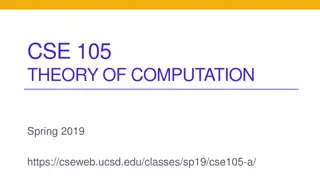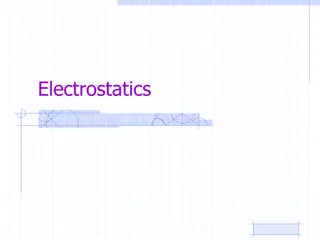Electrostatics Problems
Electrostatics problems in physics education related to electric field strength, charge interactions, and Coulomb's law. Solve and understand questions on changes in field strength, charge distances, and Coulomb's law implications.
Download Presentation

Please find below an Image/Link to download the presentation.
The content on the website is provided AS IS for your information and personal use only. It may not be sold, licensed, or shared on other websites without obtaining consent from the author.If you encounter any issues during the download, it is possible that the publisher has removed the file from their server.
You are allowed to download the files provided on this website for personal or commercial use, subject to the condition that they are used lawfully. All files are the property of their respective owners.
The content on the website is provided AS IS for your information and personal use only. It may not be sold, licensed, or shared on other websites without obtaining consent from the author.
E N D
Presentation Transcript
FACULTY OF EDUCATION FACULTY OF EDUCATION F A C U L T Y O F E D U C A T I O N Department of Curriculum and Pedagogy Physics Electrostatics Problems Science and Mathematics Education Research Group Supported by UBC Teaching and Learning Enhancement Fund 2012-2015
Question Title Question Title Electrostatics Problems Retrieved from: http://physics.stackexchange.com/questions/130915/what-does-really-attracts-a-water-stream-to-a-charged-object
Question Title Question Title Electrostatics Problems The following questions have been compiled from a collection of questions submitted on PeerWise (https://peerwise.cs.auckland.ac.nz/) by teacher candidates as part of the EDCP 357 physics methods courses at UBC.
Question Title Question Title Electrostatics Problems I An electric field strength created by charge Q is measured to be 40 N/C at a distance of 0.2 m from the center of the charge. What is the new field strength when the distance from the center of Q is changed to 0.4 m away with twice the charge of Q? A. 10 N/C B. 20 N/C C. 40 N/C D. 80 N/C
Question Title Question Title Solution Answer: B Justification: Let the electric field strength be denoted by ?. The magnitude of the electric field strength (?) is defined as the force (?) per charge (?) on the source charge (?). In other words, ? =? ? =??? ?, where ?2 is the electric force given by Coulomb's law, k is the Coulomb's law constant (? = 9.0 109 ? between the centers of ? and ?. ?2 ?2), and d is the distance So we need to use the expression, ? =??? ??2. Simplifying this ?? ?2. expression gives, ? =
Question Title Question Title Solution continued Answer: B In our case, since ? and ? are doubled, the new field strength is ????= ? (2?) (2?)2, which can be simplified to get ????= 2 4 ?? ?2= 1 2?. 1 2? =1 Thus, the new field strength is ????= 2 40 ?/? = 20?/?. Despite doubling the charge from ? to 2? and the distance from ? to 2?, our field strength ? decreased by half. Finally, note that the expression for electric field strength illustrates an inverse square relationship between the electric field strength and the distance, ? 1 ?2.
Question Title Question Title Electrostatics Problems II Two point charges (C1andC2) are fixed as shown in the setup below. Now consider a third test charge with charge -q that you can place anywhere you want in regions A, B, C, or D. In which region could you place the test charge so that the net force on the test charge is zero? A. Region A B. Region B C. Region C D. Region D C1 C2
Question Title Question Title Solution Answer: D Somewhere in region D. Justification: With the test charge and C1 being negative, there is a repulsive force on the test charge to the right. From C2, there is an attractive force on the test charge to the left. By referring to Coulomb`s law (? =??1?2 divided by a larger r so that the repulsive force between C1 and the test charge becomes smaller. However, the force from C2 and the test charge is being caused by a smaller magnitude of charge so that the attractive force between C2 and the test charge becomes smaller. At some point in region D, these two effects cancel out and there would be no net force on the test charge. ?2), we know that the force from C1 is being
Solution continued Question Title Question Title (Davor) Further explanation: In region A, the net repulsive force from C1 would be much greater in strength than the attractive force from C2. This is because the C2 charge is greater than the C1 charge, and the test charge is much closer to C2. Therefore the net force would always be to the left (the test charge would be repelled away to the left). In regions B and C, there would be a net repulsive force on the test charge from C2 to the right, as well as a net attractive force from C1 to the right as well. No matter where you placed the test charge in this region, it would always be pushed to the right.
Question Title Question Title Electrostatics Problems III In each of the four scenarios listed below, the two charges remain fixed in place as shown. Rank the electric potential energies of the four systems from the greatest to the least. d A. B = D > C > A B. C > B > A > D C. C > B = D > A D. D > A = B > C E. A > C > B = D A. 4q q d B. 3q 3q 2d C. 2q 10q d/3 D. q q
Question Title Question Title Solution Answer: B Justification: Recall that electric potential energy depends on two types of quantities: 1) electric charge (a property of the object experiencing the electrical field) and 2) the distance from the source (the location within the electric field). Somewhat similar to the gravitational potential energy, the electric potential energy is inversely proportional to ?. The electric potential energy, ??, is given by ??= ? constant, ?1 and ?2 are point charges, and ? is the distance between the two point charges. Note that ??is related to the electric force, ?, given by Coulomb's law. That is, ??= ? ?, where ? = ??1?2 ?1 ?2 ?, where ? is the Coulomb's law ?2.
Question Title Question Title Solution continued Answer: B = 4??2 4? ? ? For system A: ??= ? ? = 9??2 3? 3? ? For system B: ??= ? ? = 10??2 2? 10? 2? For system C: ??= ? ? ? ? ?/3= 3??2 For system D: ??= ? ? Since ??2 numerical coefficients determine the rank of the electric potential energies (i.e. 10 > 9 > 4 > 3). Thus B is the correct answer. ? is common to all of the above expressions, we note that the
Question Title Question Title Electrostatics Problems IV In each of the four scenarios listed below, the two charges remain fixed in place as shown. Rank the forces acting between the two charges from the greatest to the least. d A. C > B > A > D B. C > B = D > A C. B = D > C > A D. B = D > A > C E. A > C > B = D A. 4q q d B. 3q 3q 2d C. 2q 10q d/3 D. q q
Question Title Question Title Solution Answer: C Justification: Recall that the electric force is a fundamental force of the universe that exists between all charged particles. For example, the electric force is responsible for chemical bonds. The strength of the electric force between any two charged objects depends on the amount of charge that each object contains and also on the distance between the two charges. From Coulomb's law, we know that the electric force is given by ? = ??1?2 constant, ?1 and ?2 are point charges, and ? is the distance between the two point charges. ?2, where ? is the Coulomb's law Note that ? is proportional to the amount of charge and also inversely proportional to the square of the distance between the charges.
Question Title Question Title Solution continued Answer: C = 4??2 4? ? ?2 For system A: ? = ? ?2 = 9??2 3? 3? ? For system B: ? = ? ?2 2? 10? (2?)2= 5??2 For system C: ? = ? ?2 ? ? (?/3)2= 9??2 For system D: ? = ? ?2 Since ??2 the numerical coefficients determine the rank of the electric forces (i.e. 9 = 9 > 5 > 4). Thus C is the correct answer. ?2 is common to all of the above expressions, we note that
Question Title Question Title Electrostatics Problems V Given the following electric field diagrams: What are the respective charges of the yellow particles shown in diagrams (a), (b), and (c)? A. (a,b,c) = (-q, +q, +q) C. (a,b,c) = (+q, -q, -2q) E. (a,b,c) = (+2q, -2q, -q) B. (a,b,c) = (+q, q, -q) D. (a,b,c) = (-q, +q, +2q)
Question Title Question Title Solution Answer: C Justification: Recall that the direction of an electric field is defined as the direction that a positive test charge would be pushed when placed in the electric field. The electric field direction of a positively charged object is always directed away from the object. And also, the electric field direction of a negatively charged object is directed towards the object.
Question Title Question Title Solution continued Answer: C Since the field direction is directed away from (a) but towards (b) and (c), we know that the relative charges of (a,b,c) = (+,-,-) Note that the field lines allow us to not only visualize the direction of the electric field, but also to qualitatively get the magnitude of the field through the density of the field lines. From (a), (b), and (c), we can see that the density of the electric field lines in (c) is twice that of (a) or (b). We would expect the magnitude of the charge in (c) to also be twice as strong as (a) or (b). Thus, the answer choice C is correct.
Question Title Question Title Electrostatics Problems VI Below is a diagram of a charged object (conductor) at electrostatic equilibrium. Points A, B, and D are on the surface of the object, whereas point C is located inside the object. Rank the strength of the electric field at points A, B, C, and D from strongest to weakest. A. B > D > A > C B. B > D > C > A C. D > B > C > A D. D > B > A > C E. A > B > D > C
Question Title Question Title Solution Answer: D Justification: We need to understand the concept of the electric field being zero inside of a closed conducting surface of an object, which was demonstrated by Michael Faraday in the 19th century. Suppose to the contrary, if an electric field were to exist below the surface of the conductor, then the electric field would exert a force on electrons present there. This implies that electrons would be in motion. However, the assumption that we made was that for objects at electrostatic equilibrium, charged particles are not in motion. So if charged particles are in motion, then the object is not in electrostatic equilibrium. Thus, if we assume that the conductor is at electrostatic equilibrium, then the net force on the electrons within the conductor is zero. So at point C, the electric field is zero.
Question Title Question Title Solution continued Answer: D For conductors at electrostatic equilibrium, the electric fields are strongest at regions along the surface where the object is most curved. The curvature of the surface can range from flat regions to that of being a blunt point, as shown below. http://www.physicsclassroom.com/class/estatics/Lesson-4/Electric-Fields-and-Conductors We can notice that the curvature at D is greater than the curvature at B, which, in turn, is greater than the curvature at A. Thus, from the above discussion, we can say that D is the correct answer.
Question Title Question Title Solution continued (MV) Further explanations regarding electric field strength and curvature of an object can be found in the following links: https://www.youtube.com/watch?v=dUNoxVY0p3Q http://physics.stackexchange.com/questions/43068/why-is-electric-field-strong-at-sharp-edges http://www.physicsclassroom.com/class/estatics/Lesson-4/Electric-Fields-and-Conductors


